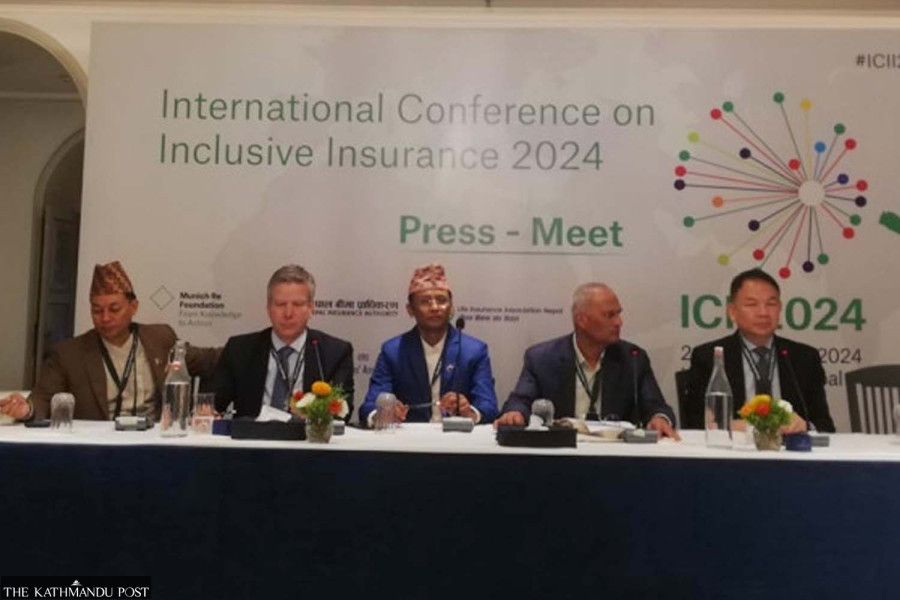Money
Disaster-prone Nepal has low insurance base: Experts
Insurance not only absorbs the shock of a loss but also reduces dependence on loan sharks, external aid, or relief from donor agencies, they say.
Post Report
Does the Nepal government have confidence in insurance? If yes, it would have insured all the structures it has built.
And when those infrastructures got damaged, for instance in floods and landslides, insurance would cover their rebuilding, said Surya Prasad Silwal, chairman of Nepal Insurance Authority, speaking at the press meeting following the 20th International Conference on Inclusive Insurance, organised in Kathmandu on Tuesday.
Experts say that insurance absorbs the shock of a loss and reduces dependence on loan sharks, external aids, or relief from donor agencies.
They said Nepal needs micro insurance to bring the people out of poverty and for sustainable economic development.
“In a country like Nepal, there is a need for microinsurance as more than 20 percent of the population lives below the poverty line, and they need protection,” said Silwal.
Insuring poor people can save them from getting poorer.
Silwal said the insurance claim in the aftermath of the September-end disaster, which claimed hundreds of lives and damaged properties worth billions, was insufficient.
The five-day conference commenced on Monday, bringing together 500 national and foreign participants, such as experts from non-government organisations, development organisations, regulatory bodies, policy experts, and the insurance industry.
As the impact of climate change has started to become visible in the Himalayas, with glacial outbursts damaging lives, property, and agricultural land, insurance can be an important tool to protect against damage, said Silwal.
The most vulnerable groups need to be insured, and they need insurance support from the government and insurance companies.
According to insurance companies, hardly 10 percent of the Nepali population is insured.
In recent flooding and landslides, nearly 250 people died, but not even 10 percent came to claim insurance.
“So inclusive insurance is important, and more awareness is needed for it,” said Silwal.
The conference will host various discussions and plenary sessions, including agendas on climate risk insurance, digital innovations in microinsurance, and strategies to overcome barriers to scaling inclusive insurance.
Experts from more than 50 countries will discuss and identify ways of accelerating growth and economic viability in inclusive insurance for emerging markets, the organiser said.
The Nepal Insurance Association, Life Insurance Association Nepal, Nepal Microinsurance Association and the Nepal Insurance Authority hosted the conference in cooperation with the Munich Re Foundation and the Microinsurance Network.
“Empowering over 2 billion people in South Asia with accessible insurance is not just a goal; it's a necessity,” said Dirk Reinhard, vice-chairman of Munich Re Foundation.
“Now, of the 2 billion people in Asia, we may reach 10 percent, maybe more, but not a lot,” he said. “Of those with some sort of insurance, only a few have access to truly reliable and affordable safety nets that really cover all major risks.”
Asia is the largest market for migrant insurance and inclusive insurance. Nepal is perfectly located next to the migrant markets of India, Bangladesh, and Pakistan, with a strong interest from Bhutan. Reinhard said about 50 percent of the participants and over 25 percent of the speakers are from those countries.
“I'm very proud to see Nepal bringing participants from countries together despite political challenges.”
“We, as insurance experts, development experts, government representatives and regulators, and many stakeholders, have an important role to play in the fight against poverty and in achieving sustainable economic development. And we are part of the solution,” said Reinhard.
“We want to promote the development and proliferation of good value insurance in emerging countries, raise awareness of the demand for insurance in local income segments and its potential, and provide opportunities for insurers, insurance and government experts to create new partnerships,” said Reinhard.
Heat waves, flooding, droughts, wildfires, and rapidly intensifying tropical cyclones caused havoc, affected life for millions of people and inflicted billions of dollars in economic losses.
“Though one might view extremes in weather and climate as the root cause or simply as a contributory factor, the resulting damage and displacement in vulnerable populations is a real and major concern for all of us,” said Lorenzo Chan, chair of the Microinsurance Network's Board of Directors.
“The impact of these and other man-made challenges undermines resilience and creates protection risks in the vulnerable populations we seek to serve and include,” said Chan.
Risk management is necessary, especially for those at the lower end of the pyramid, to continue sustainable growth and economic development, said Chan. The role of insurance in mitigating risks and enabling individuals and families to rebuild their homes, restore their businesses, and resume their lives after a calamity, death, or illness cannot be underestimated, he said.




 15.69°C Kathmandu
15.69°C Kathmandu














